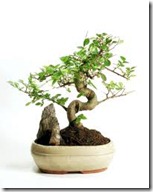 Beyond the need for good water retention and good drainage, soils have to supply all the nutrients that bonsai trees can’t get from the air or produce internally using sunlight for energy. Also, how much water retention is needed and specifically what kind and amount of nutrients will vary somewhat from species to species.
Beyond the need for good water retention and good drainage, soils have to supply all the nutrients that bonsai trees can’t get from the air or produce internally using sunlight for energy. Also, how much water retention is needed and specifically what kind and amount of nutrients will vary somewhat from species to species.
Pine and Juniper bonsai require, indeed can tolerate, much less water than other species. Flowering and fruiting bonsai species – Bougainvillea, citrus, apple and others – require much more water than average. Not only do they have to feed the trunk, branch and leaf systems of the bonsai trees, but fruits and flowers take in more water and aspirate moisture much more quickly.
Soil is a mixture of inorganic and organic material. Inorganic elements and compounds, such as clay, granite, ash and others help regulate drainage and supply nutrients.
Clay is an excellent water retainer, as is obvious from the existence of clay pots. It performs a similar service, to a smaller degree, when small pieces are embedded throughout the soil. Ash or ground volcanic rock, helps not only regulate water but supplies some of the bonsai trees needed nitrogen as well.
Organic components are made up of decomposed plant and animal matter, which provide nitrogen, phosphates and a host of other vital nutrients.
Mixing these two basic types together in the correct ratio creates the soil appropriate for a given bonsai tree species and climate. By adding relatively more grit, for example, easy drainage is increased. In the absence of more specific guidelines, a 50:50 mixture of grit and peat is a good starting point.
Grit, usually crushed granite or flint, provides good drainage while peat, typically moss peat, provides a spongy earth for bonsai trees, making for good aeration and supplying needed nutrients. Leaf mold or composted bark is sometimes a suitable substitute for peat moss.
Proportions will vary depending on the different bonsai trees species. Pine and Juniper, as noted, should have more inorganic material to provide less water retention. Often the proportions change to as much as 75:25. Provided the base of the pot contains a layer of gravel to keep the screened hole from being plugged, the exact ratio isn’t critical.
Akadama, a white Japanese clay, is the most commonly used fine-quality inorganic material used by expert bonsai artists in Japan. But it can be difficult to obtain in the US and UK. Seramis is often used as a substitute. This more standard, orange-colored, clay is a good alternative. It has the added advantage that its color changes slightly as the moisture content varies, giving a good visual indicator of drying.
When preparing soil for bonsai trees, keep in mind that all the elements of proper bonsai care are interrelated. Proper soil mixtures vary with watering regiment and are dependent on local climate, air pollution content and several other factors. Consider your individual circumstances carefully.
If you intend to put forth the time, expense and effort to grow indoor bonsai trees – which require more care than ordinary plants – soil is the last place you want to skimp on money or preparation. Soil quality is often a literal life or death alternative for your bonsai trees.

Deprecated: strpos(): Passing null to parameter #1 ($haystack) of type string is deprecated in /home/agriviek8Qv/agriviet.net/public_html/wp-includes/comment-template.php on line 2522